Strategic Information Management Report: Tesco PLC and Data Analysis
VerifiedAdded on 2019/12/03
|23
|6538
|46
Report
AI Summary
This report provides a comprehensive analysis of strategic information management (SIM) within Tesco PLC. It begins by defining the features of data and information, differentiating between data, information, knowledge, and wisdom, and outlining the criteria for selecting data to support effective decision-making, including the PDCA cycle. The report then evaluates the impact of a management information system (MIS) on Tesco, highlighting its advantages and disadvantages. Furthermore, it explores the legal responsibilities related to sourcing, sharing, and storing information, emphasizing the Data Protection Act and the types of information handled by Tesco. The report also discusses when and how information should be offered and accessed, followed by an analysis of information to identify trends and patterns. It concludes by evaluating decision-making tools and techniques, such as the Ansoff model and SWOT analysis, and methods for developing information capture to inform strategic decision-making processes, alongside the analysis of the impact of information on strategic decisions.

STRATEGIC INFORMATION
MANAGEMENT
1
MANAGEMENT
1
Paraphrase This Document
Need a fresh take? Get an instant paraphrase of this document with our AI Paraphraser
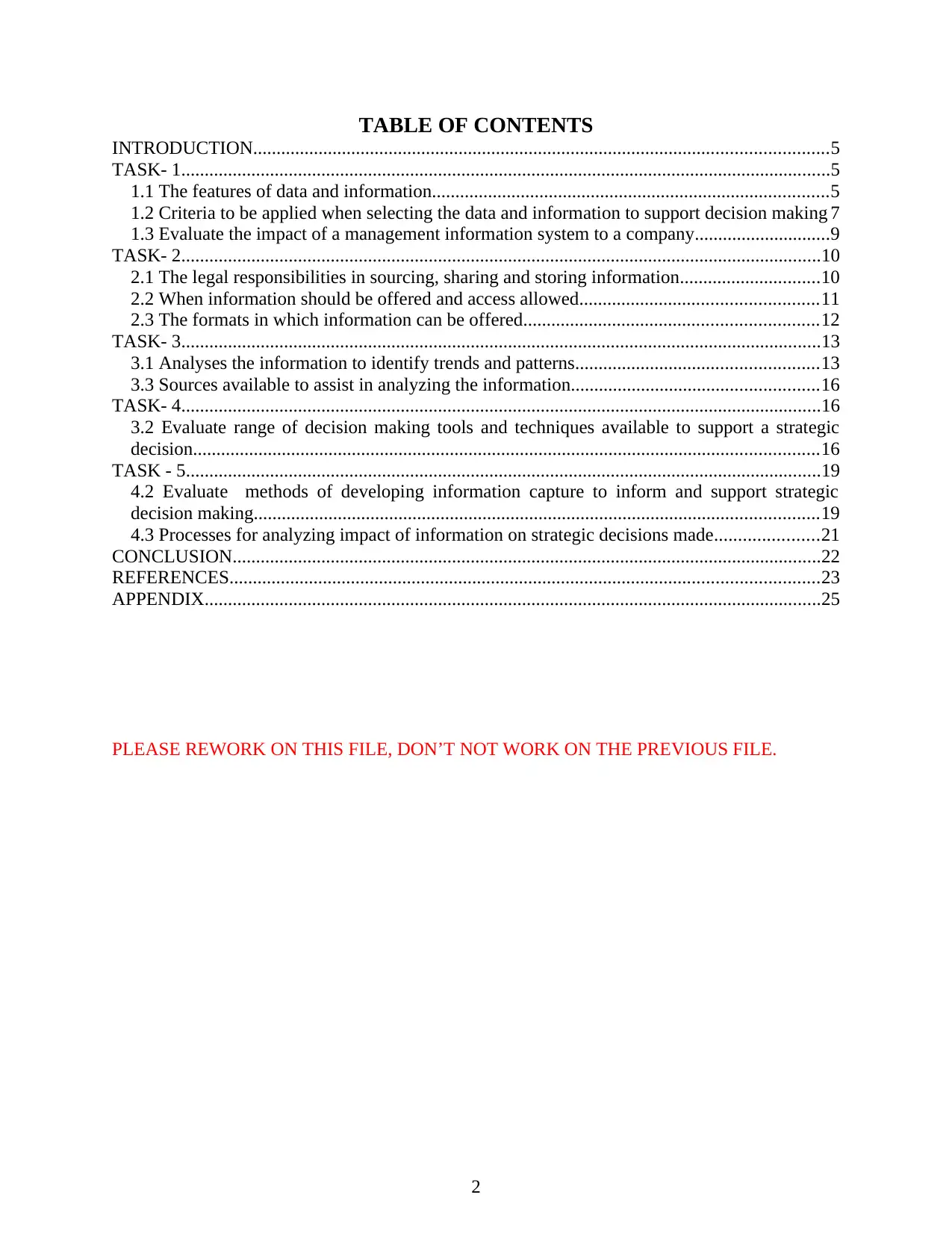
TABLE OF CONTENTS
INTRODUCTION...........................................................................................................................5
TASK- 1...........................................................................................................................................5
1.1 The features of data and information.....................................................................................5
1.2 Criteria to be applied when selecting the data and information to support decision making 7
1.3 Evaluate the impact of a management information system to a company.............................9
TASK- 2.........................................................................................................................................10
2.1 The legal responsibilities in sourcing, sharing and storing information..............................10
2.2 When information should be offered and access allowed...................................................11
2.3 The formats in which information can be offered...............................................................12
TASK- 3.........................................................................................................................................13
3.1 Analyses the information to identify trends and patterns....................................................13
3.3 Sources available to assist in analyzing the information.....................................................16
TASK- 4.........................................................................................................................................16
3.2 Evaluate range of decision making tools and techniques available to support a strategic
decision......................................................................................................................................16
TASK - 5........................................................................................................................................19
4.2 Evaluate methods of developing information capture to inform and support strategic
decision making.........................................................................................................................19
4.3 Processes for analyzing impact of information on strategic decisions made......................21
CONCLUSION..............................................................................................................................22
REFERENCES..............................................................................................................................23
APPENDIX....................................................................................................................................25
PLEASE REWORK ON THIS FILE, DON’T NOT WORK ON THE PREVIOUS FILE.
2
INTRODUCTION...........................................................................................................................5
TASK- 1...........................................................................................................................................5
1.1 The features of data and information.....................................................................................5
1.2 Criteria to be applied when selecting the data and information to support decision making 7
1.3 Evaluate the impact of a management information system to a company.............................9
TASK- 2.........................................................................................................................................10
2.1 The legal responsibilities in sourcing, sharing and storing information..............................10
2.2 When information should be offered and access allowed...................................................11
2.3 The formats in which information can be offered...............................................................12
TASK- 3.........................................................................................................................................13
3.1 Analyses the information to identify trends and patterns....................................................13
3.3 Sources available to assist in analyzing the information.....................................................16
TASK- 4.........................................................................................................................................16
3.2 Evaluate range of decision making tools and techniques available to support a strategic
decision......................................................................................................................................16
TASK - 5........................................................................................................................................19
4.2 Evaluate methods of developing information capture to inform and support strategic
decision making.........................................................................................................................19
4.3 Processes for analyzing impact of information on strategic decisions made......................21
CONCLUSION..............................................................................................................................22
REFERENCES..............................................................................................................................23
APPENDIX....................................................................................................................................25
PLEASE REWORK ON THIS FILE, DON’T NOT WORK ON THE PREVIOUS FILE.
2
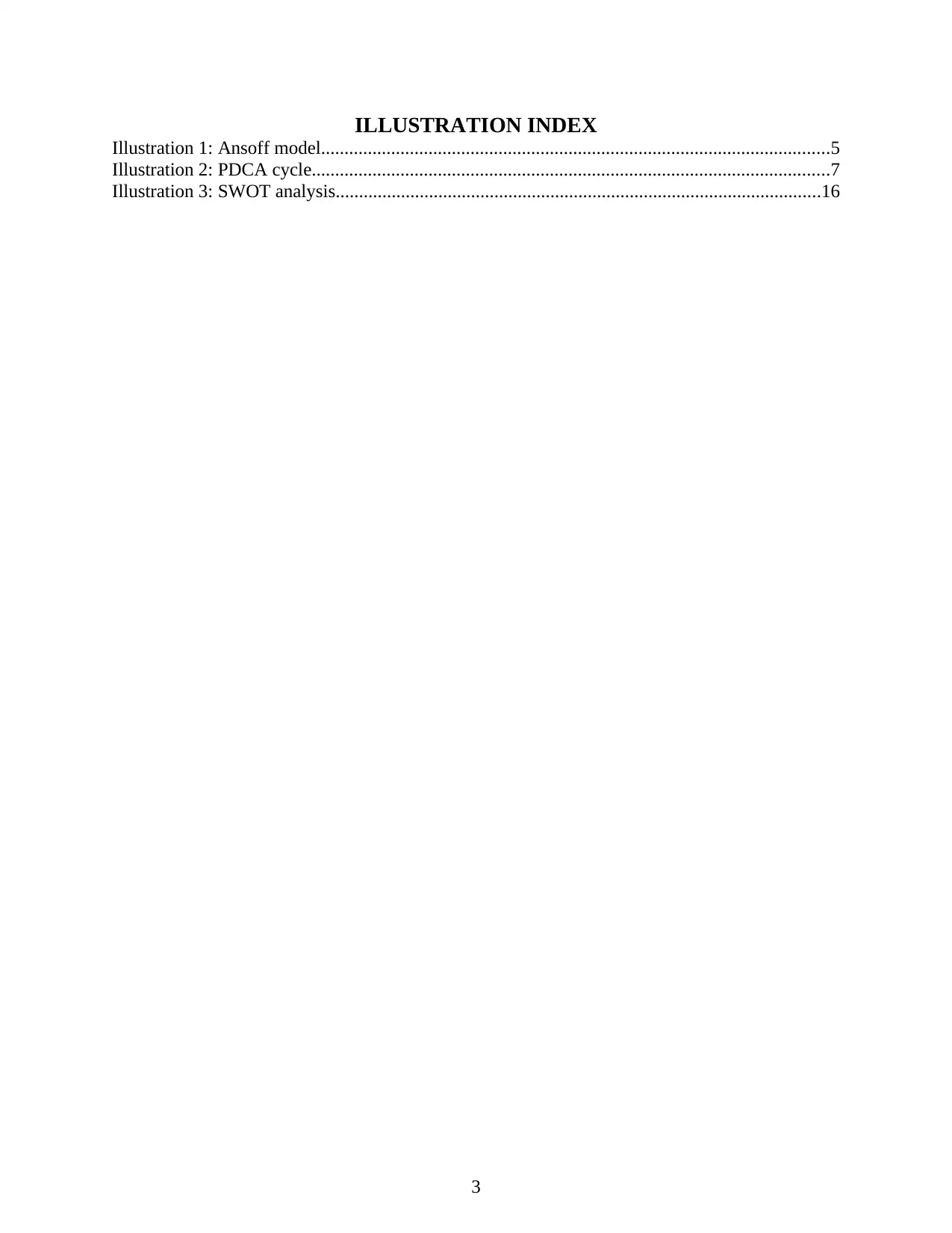
ILLUSTRATION INDEX
Illustration 1: Ansoff model.............................................................................................................5
Illustration 2: PDCA cycle...............................................................................................................7
Illustration 3: SWOT analysis........................................................................................................16
3
Illustration 1: Ansoff model.............................................................................................................5
Illustration 2: PDCA cycle...............................................................................................................7
Illustration 3: SWOT analysis........................................................................................................16
3
⊘ This is a preview!⊘
Do you want full access?
Subscribe today to unlock all pages.

Trusted by 1+ million students worldwide

INTRODUCTION
Strategic information management (SIM) is termed as the process of integrating the
applicable information so that, business can gain competitive edge in the market. To operate
business effectively, the management should determine all the information regarding their target
market so that, they can plan according to it and achieve the objectives (Hausmann, Williams
and Hardy, 2014).
For conducting the report I have chosen the Tesco PLC which is the renowned
supermarket chain in the UK and provides wide range of grocery products and services to their
market customers. Working as a manager in the Tesco superstore my role is to measure the
information within the organization that will assist in taking strategic decisions. The assignment
will mainly concentrate on the identifying the data and information of the organization to take
effective decision making within the organization.
TASK- 1
1.1 Features of data and information
Strategic decision making is the effective process that requires processing, storing and
reviewing the data and information so that, management of the organization can take proper
decision (Lee, Lee and Kang, 2005). Tesco PLC is the largest supermarket chain in the UK
market that serves different need of the customers. For supporting the strategic decision making
in the Tesco PLC, they need proper information and relevant data. The theory of Russell Ackoff,
has suggested that, the content in the individual mind can be classified into the four different
categories that is data, information, knowledge and wisdom (Walters, Jiang and Klein, 2003).
4
Strategic information management (SIM) is termed as the process of integrating the
applicable information so that, business can gain competitive edge in the market. To operate
business effectively, the management should determine all the information regarding their target
market so that, they can plan according to it and achieve the objectives (Hausmann, Williams
and Hardy, 2014).
For conducting the report I have chosen the Tesco PLC which is the renowned
supermarket chain in the UK and provides wide range of grocery products and services to their
market customers. Working as a manager in the Tesco superstore my role is to measure the
information within the organization that will assist in taking strategic decisions. The assignment
will mainly concentrate on the identifying the data and information of the organization to take
effective decision making within the organization.
TASK- 1
1.1 Features of data and information
Strategic decision making is the effective process that requires processing, storing and
reviewing the data and information so that, management of the organization can take proper
decision (Lee, Lee and Kang, 2005). Tesco PLC is the largest supermarket chain in the UK
market that serves different need of the customers. For supporting the strategic decision making
in the Tesco PLC, they need proper information and relevant data. The theory of Russell Ackoff,
has suggested that, the content in the individual mind can be classified into the four different
categories that is data, information, knowledge and wisdom (Walters, Jiang and Klein, 2003).
4
Paraphrase This Document
Need a fresh take? Get an instant paraphrase of this document with our AI Paraphraser
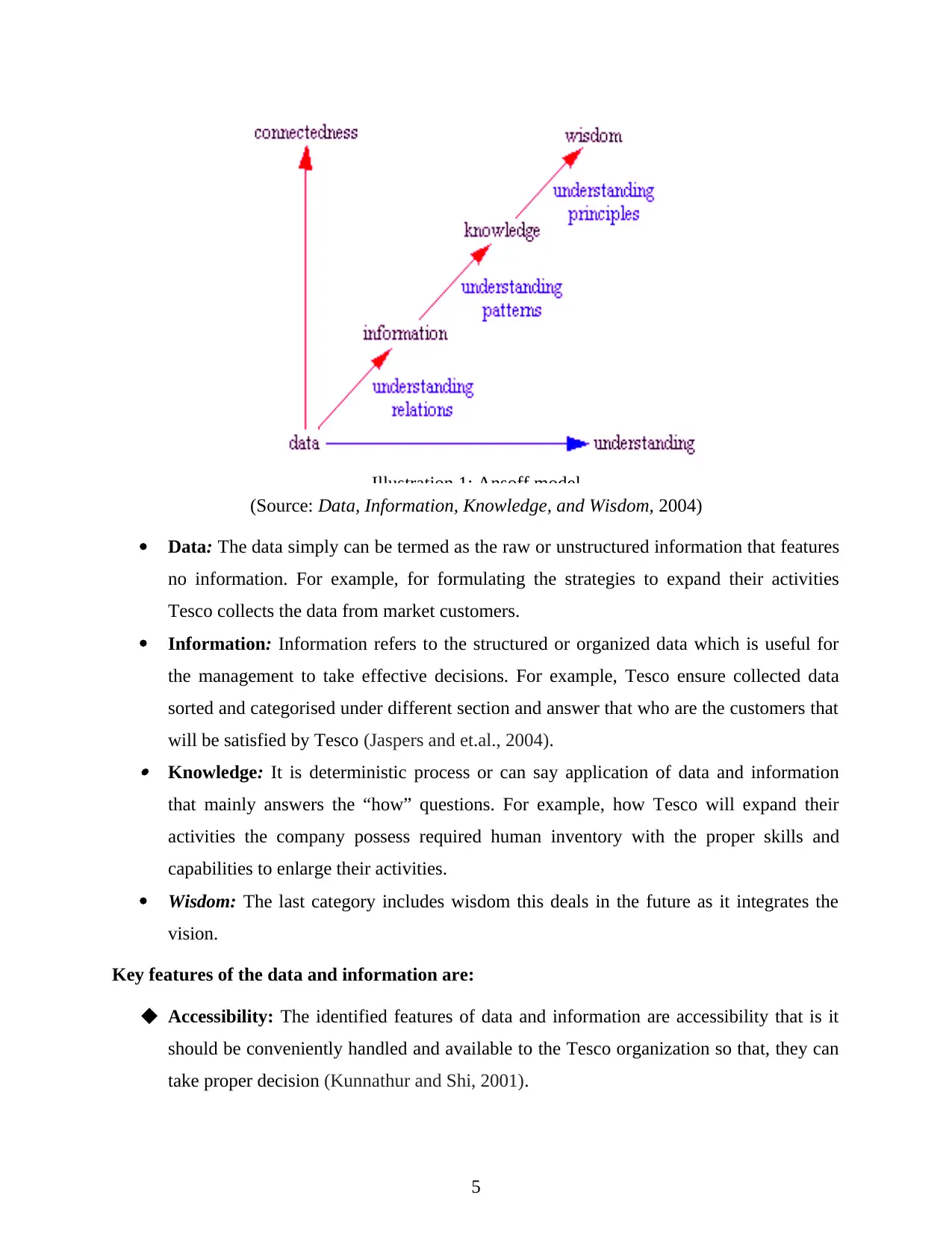
(Source: Data, Information, Knowledge, and Wisdom, 2004)
Data: The data simply can be termed as the raw or unstructured information that features
no information. For example, for formulating the strategies to expand their activities
Tesco collects the data from market customers.
Information: Information refers to the structured or organized data which is useful for
the management to take effective decisions. For example, Tesco ensure collected data
sorted and categorised under different section and answer that who are the customers that
will be satisfied by Tesco (Jaspers and et.al., 2004). Knowledge: It is deterministic process or can say application of data and information
that mainly answers the “how” questions. For example, how Tesco will expand their
activities the company possess required human inventory with the proper skills and
capabilities to enlarge their activities.
Wisdom: The last category includes wisdom this deals in the future as it integrates the
vision.
Key features of the data and information are:
Accessibility: The identified features of data and information are accessibility that is it
should be conveniently handled and available to the Tesco organization so that, they can
take proper decision (Kunnathur and Shi, 2001).
5
Illustration 1: Ansoff model
Data: The data simply can be termed as the raw or unstructured information that features
no information. For example, for formulating the strategies to expand their activities
Tesco collects the data from market customers.
Information: Information refers to the structured or organized data which is useful for
the management to take effective decisions. For example, Tesco ensure collected data
sorted and categorised under different section and answer that who are the customers that
will be satisfied by Tesco (Jaspers and et.al., 2004). Knowledge: It is deterministic process or can say application of data and information
that mainly answers the “how” questions. For example, how Tesco will expand their
activities the company possess required human inventory with the proper skills and
capabilities to enlarge their activities.
Wisdom: The last category includes wisdom this deals in the future as it integrates the
vision.
Key features of the data and information are:
Accessibility: The identified features of data and information are accessibility that is it
should be conveniently handled and available to the Tesco organization so that, they can
take proper decision (Kunnathur and Shi, 2001).
5
Illustration 1: Ansoff model
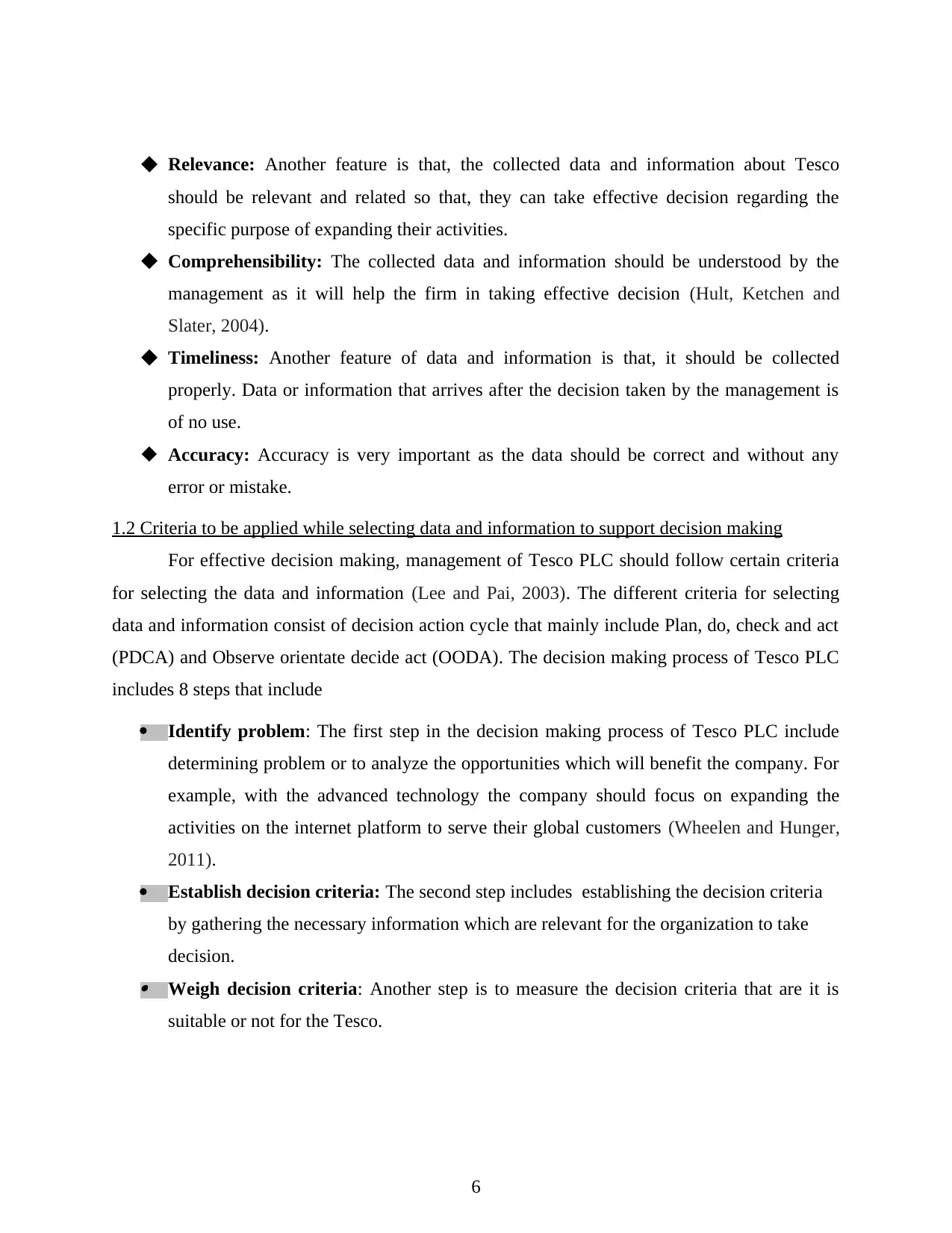
Relevance: Another feature is that, the collected data and information about Tesco
should be relevant and related so that, they can take effective decision regarding the
specific purpose of expanding their activities.
Comprehensibility: The collected data and information should be understood by the
management as it will help the firm in taking effective decision (Hult, Ketchen and
Slater, 2004).
Timeliness: Another feature of data and information is that, it should be collected
properly. Data or information that arrives after the decision taken by the management is
of no use.
Accuracy: Accuracy is very important as the data should be correct and without any
error or mistake.
1.2 Criteria to be applied while selecting data and information to support decision making
For effective decision making, management of Tesco PLC should follow certain criteria
for selecting the data and information (Lee and Pai, 2003). The different criteria for selecting
data and information consist of decision action cycle that mainly include Plan, do, check and act
(PDCA) and Observe orientate decide act (OODA). The decision making process of Tesco PLC
includes 8 steps that include
Identify problem: The first step in the decision making process of Tesco PLC include
determining problem or to analyze the opportunities which will benefit the company. For
example, with the advanced technology the company should focus on expanding the
activities on the internet platform to serve their global customers (Wheelen and Hunger,
2011).
Establish decision criteria: The second step includes establishing the decision criteria
by gathering the necessary information which are relevant for the organization to take
decision. Weigh decision criteria: Another step is to measure the decision criteria that are it is
suitable or not for the Tesco.
6
should be relevant and related so that, they can take effective decision regarding the
specific purpose of expanding their activities.
Comprehensibility: The collected data and information should be understood by the
management as it will help the firm in taking effective decision (Hult, Ketchen and
Slater, 2004).
Timeliness: Another feature of data and information is that, it should be collected
properly. Data or information that arrives after the decision taken by the management is
of no use.
Accuracy: Accuracy is very important as the data should be correct and without any
error or mistake.
1.2 Criteria to be applied while selecting data and information to support decision making
For effective decision making, management of Tesco PLC should follow certain criteria
for selecting the data and information (Lee and Pai, 2003). The different criteria for selecting
data and information consist of decision action cycle that mainly include Plan, do, check and act
(PDCA) and Observe orientate decide act (OODA). The decision making process of Tesco PLC
includes 8 steps that include
Identify problem: The first step in the decision making process of Tesco PLC include
determining problem or to analyze the opportunities which will benefit the company. For
example, with the advanced technology the company should focus on expanding the
activities on the internet platform to serve their global customers (Wheelen and Hunger,
2011).
Establish decision criteria: The second step includes establishing the decision criteria
by gathering the necessary information which are relevant for the organization to take
decision. Weigh decision criteria: Another step is to measure the decision criteria that are it is
suitable or not for the Tesco.
6
⊘ This is a preview!⊘
Do you want full access?
Subscribe today to unlock all pages.

Trusted by 1+ million students worldwide

Generate alternatives: After weighing decision criteria, the management should create
or generate several solutions so that, Tesco should ensure they should design effective
online system to serve their customers (Laudon and Laudon, 2004). Choose the best alternative: After measuring all the alternatives Tesco PLC should
choose or select the effective alternative that will assist the organization in grasping the
opportunities of expanding their business in the internet platform.
Implement: After that management of Tesco PLC should properly implement the
chosen alternative for organization so they can improve their performance and attract the
large customers (Shapiro and Varian, 2013).
Evaluate the decision: The last step in the decision making process include evaluating
the effectiveness of decision by measuring the number of customers that purchase Tesco
PLC products through online services.
Criteria to be applied while selecting data and information to support decision making
process includes ensuring PDCA cycle by the manager of Tesco. PDCA cycle includes:
(Source: Weinstein and Vasovski, 2004)
Plan: The first step is planning that is establishing the goals and objectives to meeting the
expected output. Proper plan will help the management in taking proper decision
regarding the accomplishment to objectives and goals.
Do: Another step includes implementing the plan so that they can execute according to
the plan projects.
7
Illustration 2: PDCA cycle
or generate several solutions so that, Tesco should ensure they should design effective
online system to serve their customers (Laudon and Laudon, 2004). Choose the best alternative: After measuring all the alternatives Tesco PLC should
choose or select the effective alternative that will assist the organization in grasping the
opportunities of expanding their business in the internet platform.
Implement: After that management of Tesco PLC should properly implement the
chosen alternative for organization so they can improve their performance and attract the
large customers (Shapiro and Varian, 2013).
Evaluate the decision: The last step in the decision making process include evaluating
the effectiveness of decision by measuring the number of customers that purchase Tesco
PLC products through online services.
Criteria to be applied while selecting data and information to support decision making
process includes ensuring PDCA cycle by the manager of Tesco. PDCA cycle includes:
(Source: Weinstein and Vasovski, 2004)
Plan: The first step is planning that is establishing the goals and objectives to meeting the
expected output. Proper plan will help the management in taking proper decision
regarding the accomplishment to objectives and goals.
Do: Another step includes implementing the plan so that they can execute according to
the plan projects.
7
Illustration 2: PDCA cycle
Paraphrase This Document
Need a fresh take? Get an instant paraphrase of this document with our AI Paraphraser
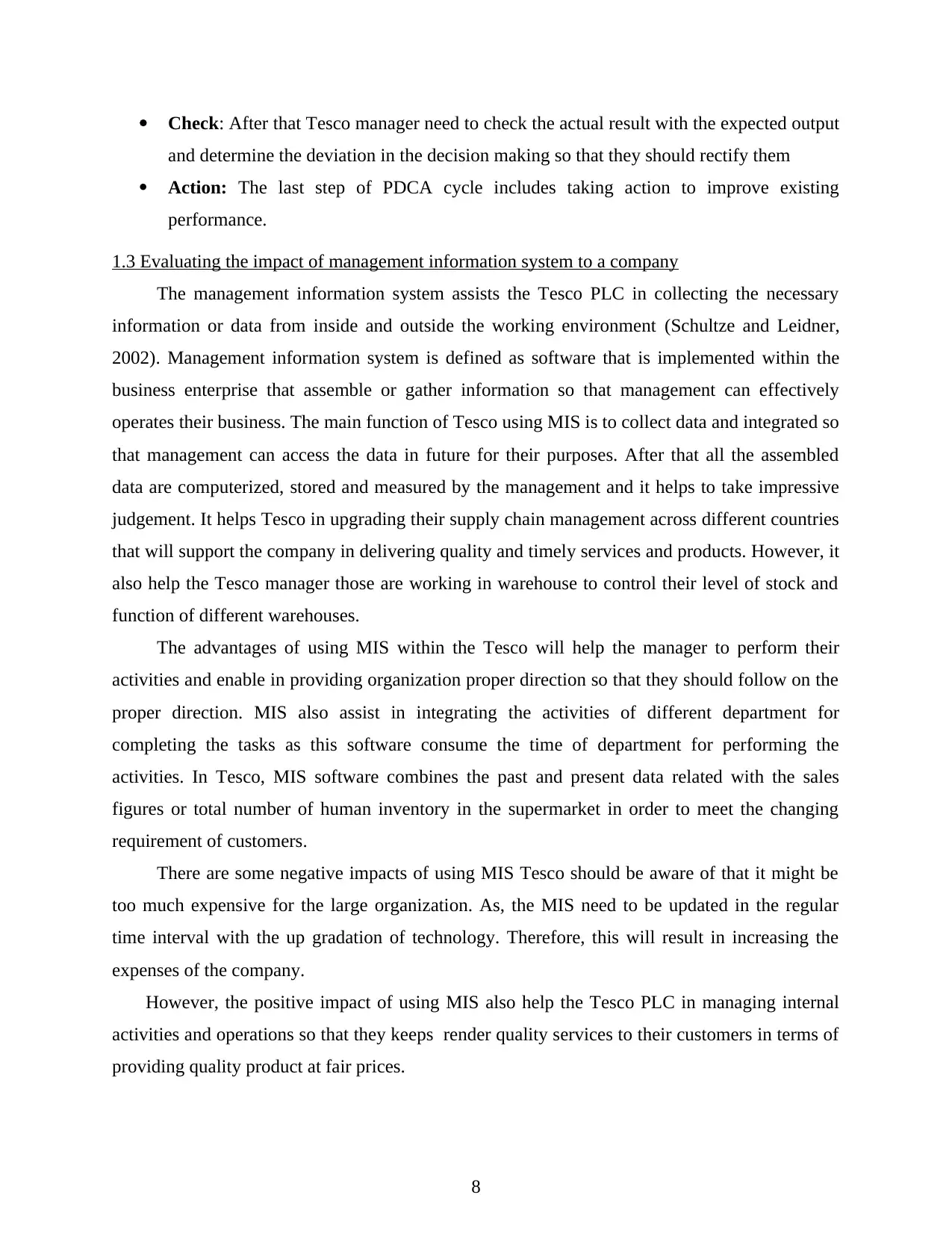
Check: After that Tesco manager need to check the actual result with the expected output
and determine the deviation in the decision making so that they should rectify them
Action: The last step of PDCA cycle includes taking action to improve existing
performance.
1.3 Evaluating the impact of management information system to a company
The management information system assists the Tesco PLC in collecting the necessary
information or data from inside and outside the working environment (Schultze and Leidner,
2002). Management information system is defined as software that is implemented within the
business enterprise that assemble or gather information so that management can effectively
operates their business. The main function of Tesco using MIS is to collect data and integrated so
that management can access the data in future for their purposes. After that all the assembled
data are computerized, stored and measured by the management and it helps to take impressive
judgement. It helps Tesco in upgrading their supply chain management across different countries
that will support the company in delivering quality and timely services and products. However, it
also help the Tesco manager those are working in warehouse to control their level of stock and
function of different warehouses.
The advantages of using MIS within the Tesco will help the manager to perform their
activities and enable in providing organization proper direction so that they should follow on the
proper direction. MIS also assist in integrating the activities of different department for
completing the tasks as this software consume the time of department for performing the
activities. In Tesco, MIS software combines the past and present data related with the sales
figures or total number of human inventory in the supermarket in order to meet the changing
requirement of customers.
There are some negative impacts of using MIS Tesco should be aware of that it might be
too much expensive for the large organization. As, the MIS need to be updated in the regular
time interval with the up gradation of technology. Therefore, this will result in increasing the
expenses of the company.
However, the positive impact of using MIS also help the Tesco PLC in managing internal
activities and operations so that they keeps render quality services to their customers in terms of
providing quality product at fair prices.
8
and determine the deviation in the decision making so that they should rectify them
Action: The last step of PDCA cycle includes taking action to improve existing
performance.
1.3 Evaluating the impact of management information system to a company
The management information system assists the Tesco PLC in collecting the necessary
information or data from inside and outside the working environment (Schultze and Leidner,
2002). Management information system is defined as software that is implemented within the
business enterprise that assemble or gather information so that management can effectively
operates their business. The main function of Tesco using MIS is to collect data and integrated so
that management can access the data in future for their purposes. After that all the assembled
data are computerized, stored and measured by the management and it helps to take impressive
judgement. It helps Tesco in upgrading their supply chain management across different countries
that will support the company in delivering quality and timely services and products. However, it
also help the Tesco manager those are working in warehouse to control their level of stock and
function of different warehouses.
The advantages of using MIS within the Tesco will help the manager to perform their
activities and enable in providing organization proper direction so that they should follow on the
proper direction. MIS also assist in integrating the activities of different department for
completing the tasks as this software consume the time of department for performing the
activities. In Tesco, MIS software combines the past and present data related with the sales
figures or total number of human inventory in the supermarket in order to meet the changing
requirement of customers.
There are some negative impacts of using MIS Tesco should be aware of that it might be
too much expensive for the large organization. As, the MIS need to be updated in the regular
time interval with the up gradation of technology. Therefore, this will result in increasing the
expenses of the company.
However, the positive impact of using MIS also help the Tesco PLC in managing internal
activities and operations so that they keeps render quality services to their customers in terms of
providing quality product at fair prices.
8
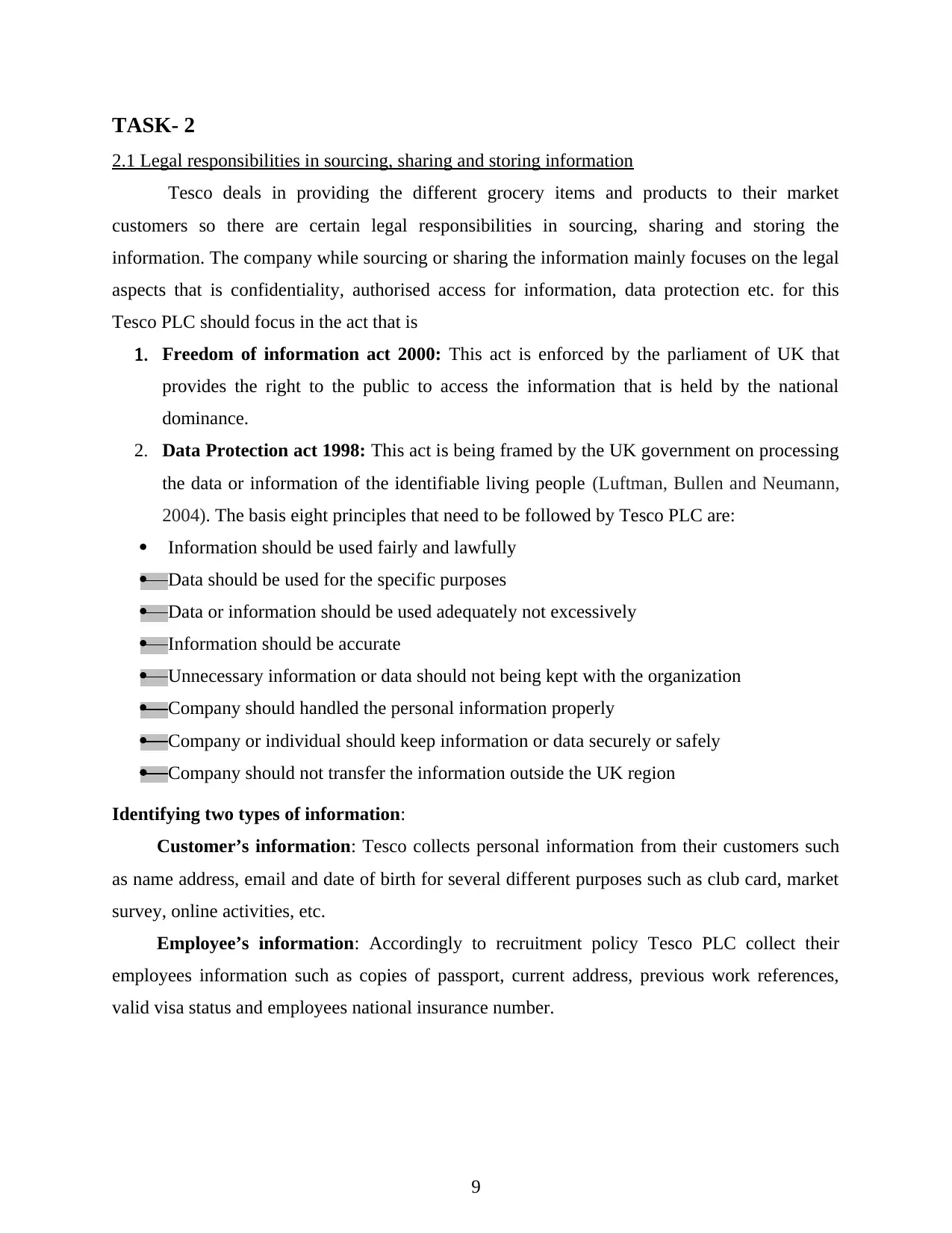
TASK- 2
2.1 Legal responsibilities in sourcing, sharing and storing information
Tesco deals in providing the different grocery items and products to their market
customers so there are certain legal responsibilities in sourcing, sharing and storing the
information. The company while sourcing or sharing the information mainly focuses on the legal
aspects that is confidentiality, authorised access for information, data protection etc. for this
Tesco PLC should focus in the act that is
1. Freedom of information act 2000: This act is enforced by the parliament of UK that
provides the right to the public to access the information that is held by the national
dominance.
2. Data Protection act 1998: This act is being framed by the UK government on processing
the data or information of the identifiable living people (Luftman, Bullen and Neumann,
2004). The basis eight principles that need to be followed by Tesco PLC are:
Information should be used fairly and lawfully
Data should be used for the specific purposes
Data or information should be used adequately not excessively
Information should be accurate
Unnecessary information or data should not being kept with the organization
Company should handled the personal information properly
Company or individual should keep information or data securely or safely
Company should not transfer the information outside the UK region
Identifying two types of information:
Customer’s information: Tesco collects personal information from their customers such
as name address, email and date of birth for several different purposes such as club card, market
survey, online activities, etc.
Employee’s information: Accordingly to recruitment policy Tesco PLC collect their
employees information such as copies of passport, current address, previous work references,
valid visa status and employees national insurance number.
9
2.1 Legal responsibilities in sourcing, sharing and storing information
Tesco deals in providing the different grocery items and products to their market
customers so there are certain legal responsibilities in sourcing, sharing and storing the
information. The company while sourcing or sharing the information mainly focuses on the legal
aspects that is confidentiality, authorised access for information, data protection etc. for this
Tesco PLC should focus in the act that is
1. Freedom of information act 2000: This act is enforced by the parliament of UK that
provides the right to the public to access the information that is held by the national
dominance.
2. Data Protection act 1998: This act is being framed by the UK government on processing
the data or information of the identifiable living people (Luftman, Bullen and Neumann,
2004). The basis eight principles that need to be followed by Tesco PLC are:
Information should be used fairly and lawfully
Data should be used for the specific purposes
Data or information should be used adequately not excessively
Information should be accurate
Unnecessary information or data should not being kept with the organization
Company should handled the personal information properly
Company or individual should keep information or data securely or safely
Company should not transfer the information outside the UK region
Identifying two types of information:
Customer’s information: Tesco collects personal information from their customers such
as name address, email and date of birth for several different purposes such as club card, market
survey, online activities, etc.
Employee’s information: Accordingly to recruitment policy Tesco PLC collect their
employees information such as copies of passport, current address, previous work references,
valid visa status and employees national insurance number.
9
⊘ This is a preview!⊘
Do you want full access?
Subscribe today to unlock all pages.

Trusted by 1+ million students worldwide
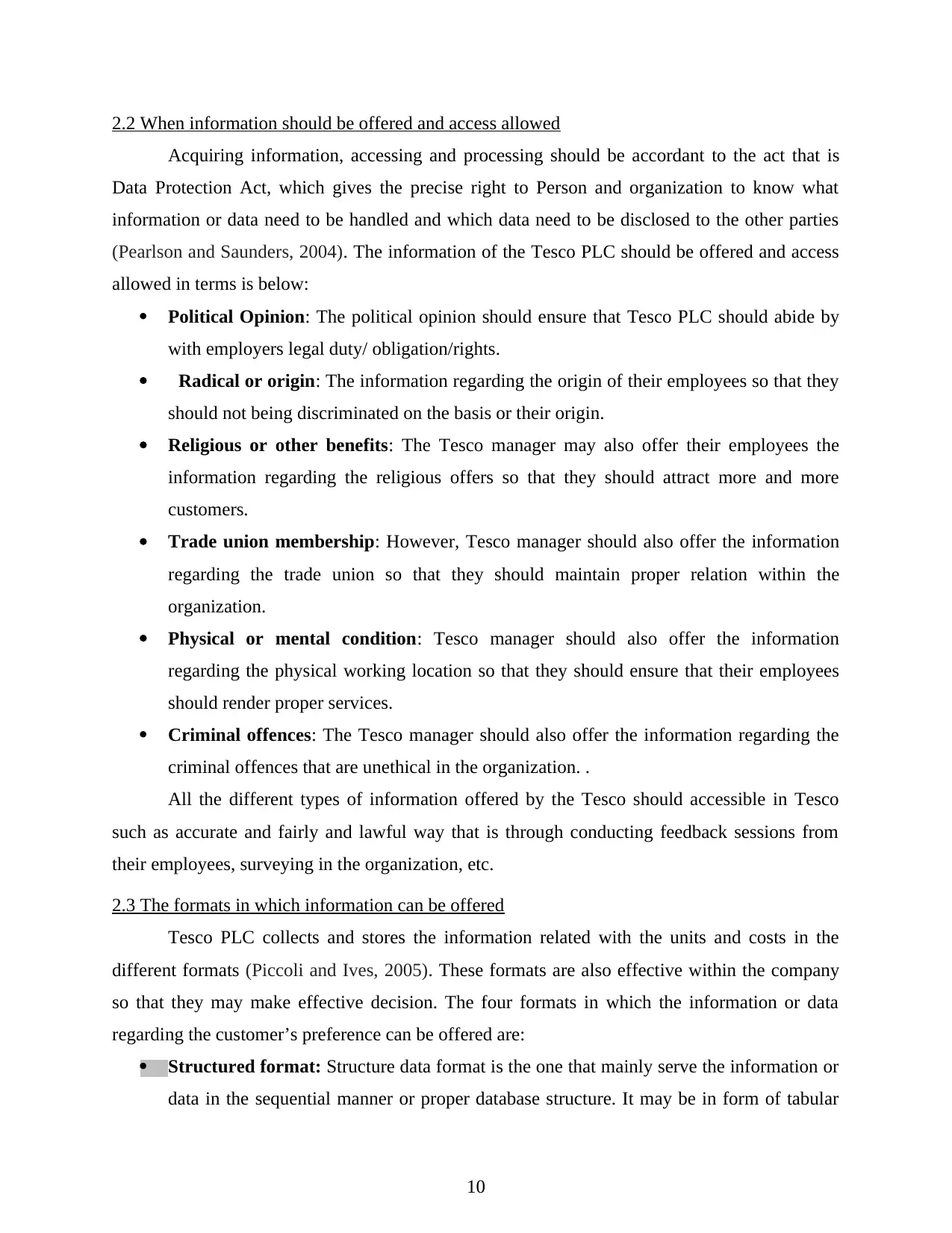
2.2 When information should be offered and access allowed
Acquiring information, accessing and processing should be accordant to the act that is
Data Protection Act, which gives the precise right to Person and organization to know what
information or data need to be handled and which data need to be disclosed to the other parties
(Pearlson and Saunders, 2004). The information of the Tesco PLC should be offered and access
allowed in terms is below:
Political Opinion: The political opinion should ensure that Tesco PLC should abide by
with employers legal duty/ obligation/rights.
Radical or origin: The information regarding the origin of their employees so that they
should not being discriminated on the basis or their origin.
Religious or other benefits: The Tesco manager may also offer their employees the
information regarding the religious offers so that they should attract more and more
customers.
Trade union membership: However, Tesco manager should also offer the information
regarding the trade union so that they should maintain proper relation within the
organization.
Physical or mental condition: Tesco manager should also offer the information
regarding the physical working location so that they should ensure that their employees
should render proper services.
Criminal offences: The Tesco manager should also offer the information regarding the
criminal offences that are unethical in the organization. .
All the different types of information offered by the Tesco should accessible in Tesco
such as accurate and fairly and lawful way that is through conducting feedback sessions from
their employees, surveying in the organization, etc.
2.3 The formats in which information can be offered
Tesco PLC collects and stores the information related with the units and costs in the
different formats (Piccoli and Ives, 2005). These formats are also effective within the company
so that they may make effective decision. The four formats in which the information or data
regarding the customer’s preference can be offered are:
Structured format: Structure data format is the one that mainly serve the information or
data in the sequential manner or proper database structure. It may be in form of tabular
10
Acquiring information, accessing and processing should be accordant to the act that is
Data Protection Act, which gives the precise right to Person and organization to know what
information or data need to be handled and which data need to be disclosed to the other parties
(Pearlson and Saunders, 2004). The information of the Tesco PLC should be offered and access
allowed in terms is below:
Political Opinion: The political opinion should ensure that Tesco PLC should abide by
with employers legal duty/ obligation/rights.
Radical or origin: The information regarding the origin of their employees so that they
should not being discriminated on the basis or their origin.
Religious or other benefits: The Tesco manager may also offer their employees the
information regarding the religious offers so that they should attract more and more
customers.
Trade union membership: However, Tesco manager should also offer the information
regarding the trade union so that they should maintain proper relation within the
organization.
Physical or mental condition: Tesco manager should also offer the information
regarding the physical working location so that they should ensure that their employees
should render proper services.
Criminal offences: The Tesco manager should also offer the information regarding the
criminal offences that are unethical in the organization. .
All the different types of information offered by the Tesco should accessible in Tesco
such as accurate and fairly and lawful way that is through conducting feedback sessions from
their employees, surveying in the organization, etc.
2.3 The formats in which information can be offered
Tesco PLC collects and stores the information related with the units and costs in the
different formats (Piccoli and Ives, 2005). These formats are also effective within the company
so that they may make effective decision. The four formats in which the information or data
regarding the customer’s preference can be offered are:
Structured format: Structure data format is the one that mainly serve the information or
data in the sequential manner or proper database structure. It may be in form of tabular
10
Paraphrase This Document
Need a fresh take? Get an instant paraphrase of this document with our AI Paraphraser
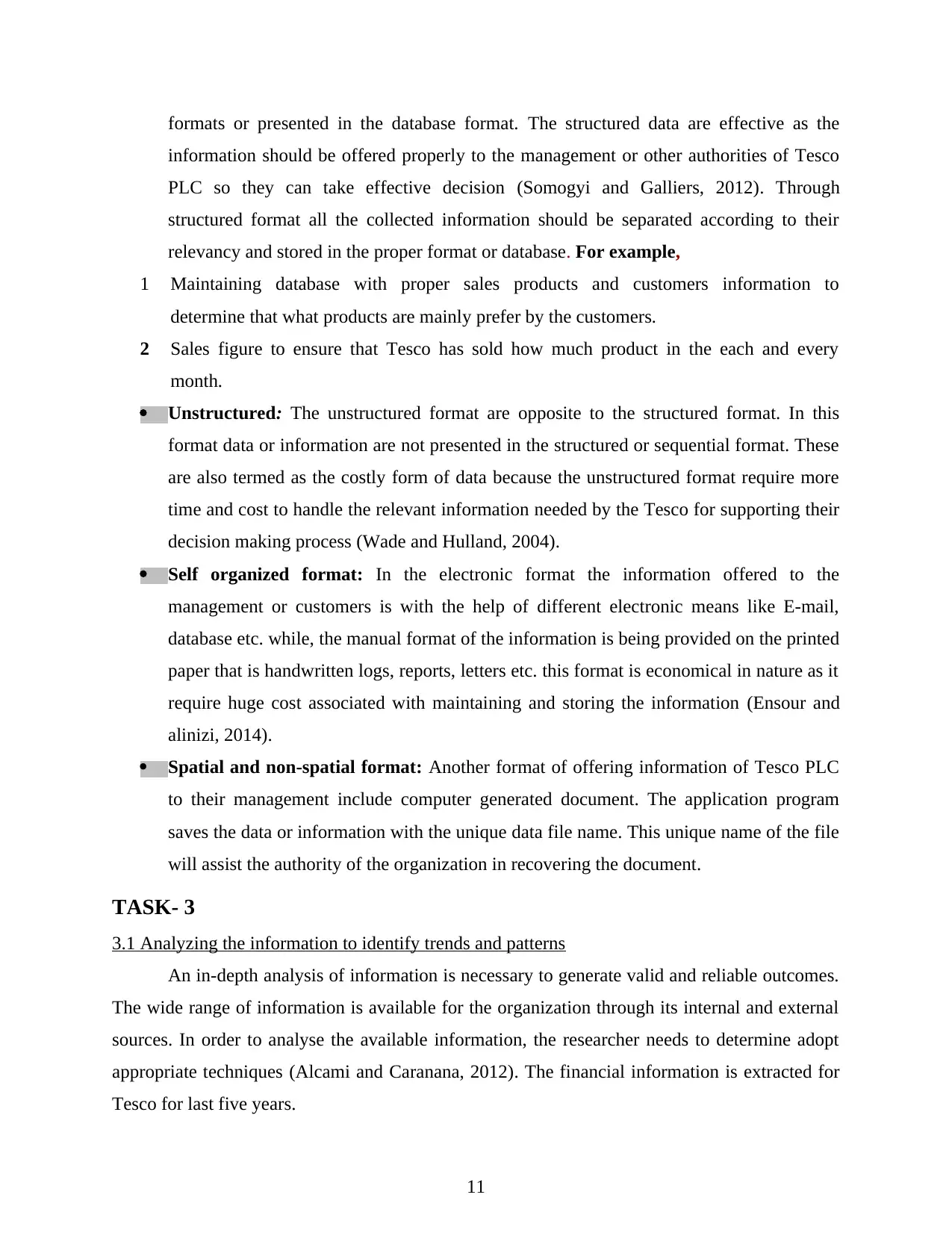
formats or presented in the database format. The structured data are effective as the
information should be offered properly to the management or other authorities of Tesco
PLC so they can take effective decision (Somogyi and Galliers, 2012). Through
structured format all the collected information should be separated according to their
relevancy and stored in the proper format or database. For example,
1 Maintaining database with proper sales products and customers information to
determine that what products are mainly prefer by the customers.
2 Sales figure to ensure that Tesco has sold how much product in the each and every
month.
Unstructured: The unstructured format are opposite to the structured format. In this
format data or information are not presented in the structured or sequential format. These
are also termed as the costly form of data because the unstructured format require more
time and cost to handle the relevant information needed by the Tesco for supporting their
decision making process (Wade and Hulland, 2004).
Self organized format: In the electronic format the information offered to the
management or customers is with the help of different electronic means like E-mail,
database etc. while, the manual format of the information is being provided on the printed
paper that is handwritten logs, reports, letters etc. this format is economical in nature as it
require huge cost associated with maintaining and storing the information (Ensour and
alinizi, 2014).
Spatial and non-spatial format: Another format of offering information of Tesco PLC
to their management include computer generated document. The application program
saves the data or information with the unique data file name. This unique name of the file
will assist the authority of the organization in recovering the document.
TASK- 3
3.1 Analyzing the information to identify trends and patterns
An in-depth analysis of information is necessary to generate valid and reliable outcomes.
The wide range of information is available for the organization through its internal and external
sources. In order to analyse the available information, the researcher needs to determine adopt
appropriate techniques (Alcami and Caranana, 2012). The financial information is extracted for
Tesco for last five years.
11
information should be offered properly to the management or other authorities of Tesco
PLC so they can take effective decision (Somogyi and Galliers, 2012). Through
structured format all the collected information should be separated according to their
relevancy and stored in the proper format or database. For example,
1 Maintaining database with proper sales products and customers information to
determine that what products are mainly prefer by the customers.
2 Sales figure to ensure that Tesco has sold how much product in the each and every
month.
Unstructured: The unstructured format are opposite to the structured format. In this
format data or information are not presented in the structured or sequential format. These
are also termed as the costly form of data because the unstructured format require more
time and cost to handle the relevant information needed by the Tesco for supporting their
decision making process (Wade and Hulland, 2004).
Self organized format: In the electronic format the information offered to the
management or customers is with the help of different electronic means like E-mail,
database etc. while, the manual format of the information is being provided on the printed
paper that is handwritten logs, reports, letters etc. this format is economical in nature as it
require huge cost associated with maintaining and storing the information (Ensour and
alinizi, 2014).
Spatial and non-spatial format: Another format of offering information of Tesco PLC
to their management include computer generated document. The application program
saves the data or information with the unique data file name. This unique name of the file
will assist the authority of the organization in recovering the document.
TASK- 3
3.1 Analyzing the information to identify trends and patterns
An in-depth analysis of information is necessary to generate valid and reliable outcomes.
The wide range of information is available for the organization through its internal and external
sources. In order to analyse the available information, the researcher needs to determine adopt
appropriate techniques (Alcami and Caranana, 2012). The financial information is extracted for
Tesco for last five years.
11

Table 1: Revenue and profitability of Tesco in last five years
2015 2014 2013 2012 2011
Revenue 61276.71 63557.00 63406.00 63916.00 60455.00
Operating profit -5698.00 2631.00 2382.00 4182.00 3917.00
Net profit -5626.51 1912.00 1528.00 3164.00 2777.00
Figure 1: Revenue of Tesco
The graph presented above indicates that revenue of Tesco has increased for year 2012
and 2014. However, the same has been decreased for year 2015 which indicates reduction in
market share of businesses. It can be said that competition within retail sector is increasing on
continuous basis. This in turn leads to reduction in sales for Tesco in year 2015 (Hausmann,
Williams and Hardy, 2014). The business unit should therefore emphasize on creation of strategy
that provides an edge over competitors. The increased level of revenue is expected to support
business operations for long run.
12
2015 2014 2013 2012 2011
Revenue 61276.71 63557.00 63406.00 63916.00 60455.00
Operating profit -5698.00 2631.00 2382.00 4182.00 3917.00
Net profit -5626.51 1912.00 1528.00 3164.00 2777.00
Figure 1: Revenue of Tesco
The graph presented above indicates that revenue of Tesco has increased for year 2012
and 2014. However, the same has been decreased for year 2015 which indicates reduction in
market share of businesses. It can be said that competition within retail sector is increasing on
continuous basis. This in turn leads to reduction in sales for Tesco in year 2015 (Hausmann,
Williams and Hardy, 2014). The business unit should therefore emphasize on creation of strategy
that provides an edge over competitors. The increased level of revenue is expected to support
business operations for long run.
12
⊘ This is a preview!⊘
Do you want full access?
Subscribe today to unlock all pages.

Trusted by 1+ million students worldwide
1 out of 23
Related Documents
Your All-in-One AI-Powered Toolkit for Academic Success.
+13062052269
info@desklib.com
Available 24*7 on WhatsApp / Email
![[object Object]](/_next/static/media/star-bottom.7253800d.svg)
Unlock your academic potential
Copyright © 2020–2025 A2Z Services. All Rights Reserved. Developed and managed by ZUCOL.





